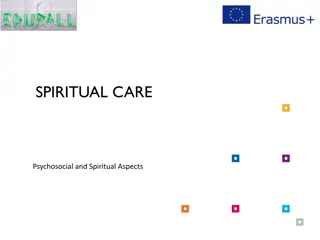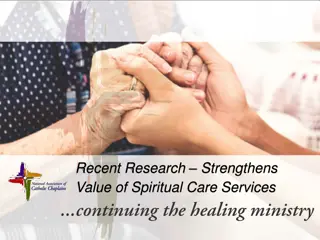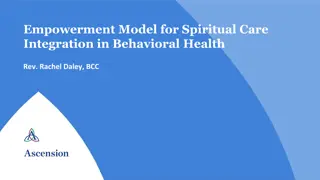Assessing and Addressing Spiritual Needs
Explore the significance of assessing spiritual needs and providing spiritual care in partnership. Embrace reflective practices and learn key questions to assess spiritual needs effectively. Understand the dynamics of assessment and prepare for patient visits sensitively. Start the process of assessing and addressing by creating a safe space and focusing on matters of faith and spirituality.
Download Presentation

Please find below an Image/Link to download the presentation.
The content on the website is provided AS IS for your information and personal use only. It may not be sold, licensed, or shared on other websites without obtaining consent from the author. Download presentation by click this link. If you encounter any issues during the download, it is possible that the publisher has removed the file from their server.
E N D
Presentation Transcript
Assessing and Addressing Spiritual Needs Spiritual Care Partners
Being Reflective Practitioners Finding God in all things: Nothing is considered outside the purview of the spiritual life. Ignatian spirituality considers everything an important element of your spiritual life. Fr. James Martin, SJ This frame of mind helps us embrace all aspects of personhood as being under the umbrella of spirituality: the spiritual, emotional, psychological, and physical.
Key Questions When assessing spiritual needs, here are some key questions to consider: What distinguishes spiritual needs from other types of needs? How do we know if a situation requires the services of a spiritual caregiver or someone from a different discipline (nurse, social worker, etc.)? What should our goals be? How do we know if we have been helpful to the patient? c.f. Fitchett, p. 11
The Dynamics of Assessment The art of assessment involves developing self-awareness in order to identify when our emotions are getting in the way of being truly helpful. Otherwise, we may end up seeking to meet our own needs rather than the patient s. Sometimes we encounter people whose beliefs differ from ours and this can be uncomfortable. Remain engaged despite that uncomfortable feeling. Maintain a stance of availability.
Preparing for a Visit 1. Set aside your desired outcome for the visit. Outcomes should be patient-led as they emerge in the midst of conversation. 2. Keep assumptions in check and maintain self- awareness about personal biases. Example: While on the floor, you hear from a nurse that the patient is an atheist. Not having met the patient, leave stereotypes about atheists behind. Even if the patient does not believe in God or belong to a formal religious tradition, you cannot assume that he/she is not spiritual.
Process of Assessing and Addressing Start with self-assessment:Ask yourself, Am I truly free to receive this person as she/he is in this moment? Create a safe space: Accept people as they are without judgment. Pay attention to feelings: What emotions does the person seem to be experiencing? Worry, despair, joy, contentment, apathy, indifference, etc.? Focus on validating the person s feelings.
Pay attention to matters of faith/spirituality: Does the person have a religious preference? If so, does faith or spirituality provide a sense of strength? What religious practices help him/her cope (prayer, sacred scriptures, attending church/synagogue/ mosque, etc.)? Look for ways to provide support for the person s spiritual needs directly or by referral to a chaplain. Does the person have other sources of meaning/ purpose? Are there any signs of spiritual distress?
Spiritual Distress Distress experienced during an emotional crisis in which one s belief systems and faith fail to provide guidance, comfort, meaning, and hope. Often marked by a lack of hope, anguish, and a feeling of cutoff from spiritual resources, especially from God or a higher power.
Other Spiritual Care Interventions Reframing Helping people see examples of hope in their current stories. Envisioning Helping people envision a hopeful future story.
Practical Example You enter the room of a 60-year-old female who just underwent knee surgery. After introducing yourself and exchanging a few words with her, you ask her how her day is going. She notes that she is frustrated because her pain has been hard to manage. You affirm her feelings and ask her what gives her strength in the midst of this challenge. She says her faith in God is a major source of support.
Practical Example Assessing the needs: Physical Need: relief from pain Emotional Need: validation of her feelings (frustration) Spiritual Need: to have her faith in God affirmed Addressing the needs: Physical: asking if she needs to speak with a nurse for pain management Emotional: showing empathy; affirming her feeling of frustration without trying to fix Spiritual: Exploring further what her faith means to her; encouraging her to share about her faith journey and faith community Offering to pray
Self-Reflection after the Visit What help did I provide? What opportunities did I miss? Was I fully present to hear the person s story? If I happen to see the patient again during another shift, what topics from our previous conversation might I keep in mind to bring up again? Example: You were saying last week such and such about your circumstances. I would love to hear more if you are willing to share.
Bottom Line The main goal: simply, to provide help Look for opportunities to provide help spiritually, emotionally, or physically. No need to overthink assessment. Applying a step-by- step process or going through a mental checklist will prevent you from being fully present.
Discussion Making Referrals to Chaplains Facilitator to review the referral guidelines with group
Sources Fitchett, George. Assessing Spiritual Needs: A Guide for Caregivers. Lima, Ohio: Academic Renewal Press, 2002. Martin, James. The Jesuit Guide to (Almost) Everything: A Spirituality for Real Life. New York: HarperCollins, 2010.























